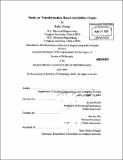Study on transformation-based invisibility cloaks
Author(s)
Zhang, Baile
DownloadFull printable version (35.24Mb)
Other Contributors
Massachusetts Institute of Technology. Dept. of Electrical Engineering and Computer Science.
Advisor
David Staelin and Bae-Ian Wu.
Terms of use
Metadata
Show full item recordAbstract
The combination of the development of modern metamaterials, which are artificial materials whose constitutive parameters can be engineered to achieve special functions, and the coordinate transformation theory, has offered an unprecedented opportunity for realizing invisibility cloaking. Coordinate transformation theory predicts that by squeezing the space to form a "hole" in it, any object inside the "hole" becomes completely invisible from electromagnetic waves. A metamaterial shell can thus be designed to mimic this space squeezing and function as an invisibility cloak whose user cannot be seen by others. In this thesis, a systematic electromagnetic study of transformation-based invisibility cloaks is provided based on the macroscopic Maxwell equations. Analytic scattering models are formulated for studying ideal and non-ideal invisibility cloaks. The physics behind perfect invisibility that the coordinate transformation theory did not show is explored by analytically calculating the spatial distribution of electromagnetic fields. Firstly, it is shown that an external electromagnetic wave illuminating a cylindrical cloak will induce electric and magnetic surface currents along the 0 direction at the inner boundary of this cloak. These surface currents have no counterparts in the transformation theory because they do not exist before transformation. Secondly, the reciprocity of a spherical cloak is demonstrated by showing that radiation from an active device in the concealed region is confined in the concealed region. The mechanism is that the outgoing radiation will induce surface voltages at the inner boundary of the cloak that reflect all waves back. (cont.) These physical surface voltages provides a set of mathematical boundary conditions requiring normal D and normal B to vanish on the interface. Finally, the mechanical response of the cloak to external electromagnetic waves is analyzed by calculating the Lorentz force distribution. It is shown that an incoming plane wave tends to expand the bulk of a cloak while squeezing the outer boundary of the cloak at the same time. The recoil forces of these forces provides an alternative explanation for the bending of rays or photons. More realistic cases with perturbed constitutive parameters are analyzed. It is shown that under certain symmetric lossy conditions, the spherical cloak is still invisible for a back-scattering detector due to impedance matching, while a cylindrical cloak with the same lossy conditions is visible. More emphasis is laid on the effect of dispersion associated with metamaterials. By applying the Drude and Lorentz types of dispersion to the radial permittivity and radial permeability of a spherical cloak, it is shown that electromagnetic waves with different frequencies have different depths of penetration and thus form a rainbow-like field distribution inside the cloak. A quasi-monochromatic wave will experience a blue-shift in the forward propagating direction. Transmission of a Gaussian pulse through this dispersive cloak is discussed. It is shown that group velocity and energy transport velocity are not well-defined when the wave is approaching the inner boundary because the wave is seriously distorted. However, when the frequency band is narrow enough, we are still able to define the time-delay of the signal arriving at a target plane behind the cloak. (cont.) A counterintuitive volcano-shaped time-delay is demonstrated as a concrete example. An electromagnetic detection method is introduced for detecting a perfect cloak. While photons can be guided by the cloak along curved trajectories within the cloak, a moving charged particle will still follow a straight trajectory due to its inertia and thus generate radiation. We extend the previous Frank and Tamm's theory of Cerenkov radiation in isotropic and homogeneous media to the case of a perfect spherical cloak that is both anisotropic and inhomogeneous. From the transformation viewpoint, the radiation is from the nonuniform motion of the charged particle along a bent curve in the virtual space. The transition radiations that occur at the incident point and emitting point when the particle enters and leaves the cloak in the physical space correspond to the abrupt velocity changes at the corresponding points in the virtual space. The transition radiation during the piercing process in the physical space corresponds to the deceleration and acceleration radiation (Bremsstrahlung) and synchrotron radiation in virtual space. In our demonstrated spherical cloak with inner radius of 1 pm and outer radius of 2/m, it is obtained that within the frequency range from 500 THz to 501 THz, a charge package of 1000 electrons moving with 0.9c can generate radiation energy equivalent to about 78 photons. The practical implementation is considered. For simplified cloaks that are often preferred in experiments, the influences of nonlinear transformation and incident angle are first studied. (cont.) It is seen that a square root transformation which forces the waves to be guided close to the outer boundary is more invisible than those generated by either linear or quadratic transformation. Simplified cylindrical cloaks may produce a larger scattering at nonnormal incidences than that from an object without any cloak. In addition, we suggest using a small number of homogeneous and anisotropic metamaterial layers to construct a practical cloak with satisfying performance with normal incidence and oblique incidence. Genetic algorithm was used to optimize the practical multi-layer structures. It is shown that using an optimized 4-layer cloak, the normalized scattering cross section from a perfect electric conductor cylinder can be reduced from 2.19 to 0.0039 with normal incidence. Another optimized 4-layer cloak working for the incidence of 30° is shown able to reduce the scattering cross section from 1.175 to 0.013. The latter cloak exhibits reduce scattering over a large range of incidence angles.
Description
Thesis (Ph. D.)--Massachusetts Institute of Technology, Dept. of Electrical Engineering and Computer Science, 2009. Cataloged from PDF version of thesis. Includes bibliographical references (p. 155-161).
Date issued
2009Department
Massachusetts Institute of Technology. Department of Electrical Engineering and Computer SciencePublisher
Massachusetts Institute of Technology
Keywords
Electrical Engineering and Computer Science.